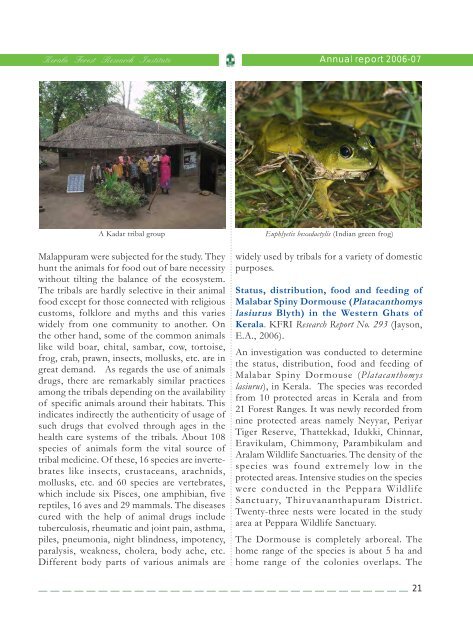Annual report <strong>2006</strong>-<strong>07</strong><strong>Kerala</strong> <strong>Forest</strong> <strong>Research</strong> <strong>Institute</strong>tested, the performance of which was as goodas or even better than the unformulatedHpNPV.The study also gave an opportunity to understandgenetic variation within HpNPVpopulation. Eight HpNPV isolates could becharacterized using Restriction Endonucleaseanalysis wherein Hind III was used as therestriction enzyme. The estimated molecularweights of the genome of HpNPV isolatesranged from 79.37 kbp to 112.14 kbp.....................................................................................................................................................................................Bamboo sector in <strong>Kerala</strong>: baseline datagener-ation for developing an action plan.KFRI <strong>Research</strong> Report No. 291 (Muraleedharan,P.K., Anitha, V., Krishnankutty, C.N., Gnanaharan,R., Vijayakumaran Nair, P., Sankar, S. andSeetha-lakshmi, K.K., <strong>2006</strong>).The basic information on bamboo sector inthe State is inadequate. The study has generatedbaseline data relating to resources, consumptionpattern, socio-economic and livelihood conditionsof the bamboo dependents, marketing,techno-logy and product development.The study has used both primary and secondarydata. The total standing crop of bamboo inhomesteads in <strong>Kerala</strong> is estimated as 13.61million culms and its green weight is 0.331million tonnes. There are six species of bambooavailable in homesteads including reed ofwhich Bambusa bambos is the dominant species,accounting for 96 per cent. This is followedby B. vulgaris and reed, constituting 2.23 percent and 1.38 per cent respectively. There hasalso been a reduction in growing stock inhomesteads from 0.408 million tonnes during1987-88 to 0.331 million tonnes during 2004-05. Based on 1997 imagery, bamboo resourcein forest areas was estimated as 2.63 million.The total consumption of bamboo and reedin the State is estimated as 0.256 million tonnes.The per capita income of the artisans isestimated as less than Rs. 6,000 which issignificantly lower than that of the State average(Rs. 24,053) and thus they live below thepoverty line. The traditional bamboo basedindustry, which was an important source ofemployment to Marginalized BambooDependents (MBDs), is now on a decline.Bamboo is sold through primary and wholesaledepots in <strong>Kerala</strong>. There are 95 primary depotslocated in various districts catering to the localrequirements, whereas the 35 wholesale depotslocated in Palakkad District fulfill the demandmostly from the neighboring State of TamilNadu. Of the total quantity of 74,000 metrictones, green weight of bamboo marketedthrough the depots in <strong>Kerala</strong> during 2004-05,primary depots account for 48% and wholesaledepots, the remaining 52%. It is evident thatquantity of bamboo exported to Tamil Naduhas been declining considerably.The main problems in bamboo handicraft/furniture sector are: lack of adequate rawmaterials, low level of adoption of improvedtechnology, low investment, inadequatemarketing facilities, etc. There is scope for usingimproved technology in handicraft sectorwithout affecting employment. The studyupholds the view that a holistic approach isrequired for overall development of thebamboo sector in the State and this requiresformulation of a bamboo policy and properplanning.Ethno-zoological studies on the tribals ofPalaghat and Malappuram Districts of<strong>Kerala</strong>. KFRI <strong>Research</strong> Report No. 292(Padmanabhan, P. <strong>2006</strong>).In <strong>Kerala</strong>, there are about 3 lakhs of tribals,who continue to use various wild and domesticatedanimals and plants for food, drugs,customs, game and religious purposes. Tentribal groups in Palaghat and six groups in20
<strong>Kerala</strong> <strong>Forest</strong> <strong>Research</strong> <strong>Institute</strong>Annual report <strong>2006</strong>-<strong>07</strong>A Kadar tribal group...................................................................................................................................................................................Malappuram were subjected for the study. Theyhunt the animals for food out of bare necessitywithout tilting the balance of the ecosystem.The tribals are hardly selective in their animalfood except for those connected with religiouscustoms, folklore and myths and this varieswidely from one community to another. Onthe other hand, some of the common animalslike wild boar, chital, sambar, cow, tortoise,frog, crab, prawn, insects, mollusks, etc. are ingreat demand. As regards the use of animalsdrugs, there are remarkably similar practicesamong the tribals depending on the availabilityof specific animals around their habitats. Thisindicates indirectly the authenticity of usage ofsuch drugs that evolved through ages in thehealth care systems of the tribals. About 108species of animals form the vital source oftribal medicine. Of these, 16 species are invertebrateslike insects, crustaceans, arachnids,mollusks, etc. and 60 species are vertebrates,which include six Pisces, one amphibian, fivereptiles, 16 aves and 29 mammals. The diseasescured with the help of animal drugs includetuberculosis, rheumatic and joint pain, asthma,piles, pneumonia, night blindness, impotency,paralysis, weakness, cholera, body ache, etc.Different body parts of various animals areEuphlyetis hexadactylis (Indian green frog)widely used by tribals for a variety of domesticpurposes.Status, distribution, food and feeding ofMalabar Spiny Dormouse (Platacanthomyslasiurus Blyth) in the Western Ghats of<strong>Kerala</strong>. KFRI <strong>Research</strong> Report No. 293 (Jayson,E.A., <strong>2006</strong>).An investigation was conducted to determinethe status, distribution, food and feeding ofMalabar Spiny Dormouse (Platacanthomyslasiurus), in <strong>Kerala</strong>. The species was recordedfrom 10 protected areas in <strong>Kerala</strong> and from21 <strong>Forest</strong> Ranges. It was newly recorded fromnine protected areas namely Neyyar, PeriyarTiger Reserve, Thattekkad, Idukki, Chinnar,Eravikulam, Chimmony, Parambikulam andAralam Wildlife Sanctuaries. The density of thespecies was found extremely low in theprotected areas. Intensive studies on the specieswere conducted in the Peppara WildlifeSanctuary, Thiruvananthapuram District.Twenty-three nests were located in the studyarea at Peppara Wildlife Sanctuary.The Dormouse is completely arboreal. Thehome range of the species is about 5 ha andhome range of the colonies overlaps. The21
















